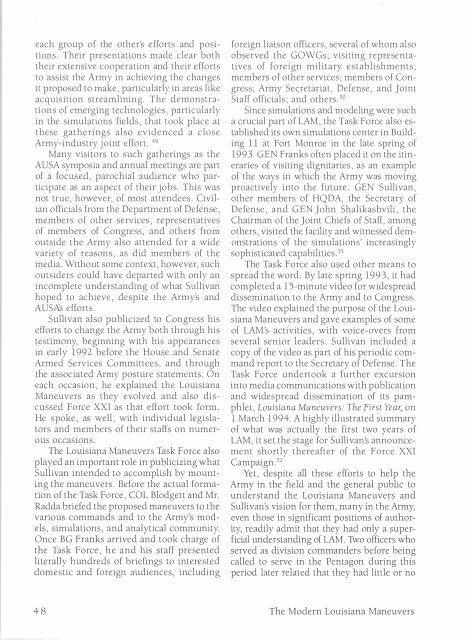The Modern Louisiana Maneuvers - US Army Center Of Military History
The Modern Louisiana Maneuvers - US Army Center Of Military History
The Modern Louisiana Maneuvers - US Army Center Of Military History
Create successful ePaper yourself
Turn your PDF publications into a flip-book with our unique Google optimized e-Paper software.
each group of the other's efforts and positions<br />
. <strong>The</strong>ir presentations made clear both<br />
their extensive cooperation and their efforts<br />
to assist the <strong>Army</strong> in achieving the changes<br />
it proposed to make, particularly in areas like<br />
acquisition streamlining. <strong>The</strong> demonstrations<br />
of emerging technologies, particularly<br />
in the simulations fields, that took place at<br />
these gatherings also evidenced a close<br />
<strong>Army</strong>-industry joint effort. 49<br />
Many visitors to such gatherings as the<br />
A<strong>US</strong>A symposia and annual meetings are part<br />
of a focused, parochial audience who participate<br />
as an aspect of their jobs. This was<br />
not true, however, of most attendees. Civilian<br />
officials from the Department of Defense,<br />
members of other services, representatives<br />
of members of Congress, and others from<br />
outside the <strong>Army</strong> also attended for a wide<br />
variety of reasons, as did members of the<br />
media. Without some context, however, such<br />
outsiders could have departed with only an<br />
incomplete understanding of what Sullivan<br />
hoped to achieve, despite the <strong>Army</strong>'s and<br />
A<strong>US</strong>A's efforts.<br />
Sullivan also publiCized to Congress his<br />
efforts to change the <strong>Army</strong> both through his<br />
testimony, beginning with his appearances<br />
in early 1992 before the House and Senate<br />
Armed Services Committees, and through<br />
the associated <strong>Army</strong> posture statements. On<br />
each occasion, he explained the <strong>Louisiana</strong><br />
<strong>Maneuvers</strong> as they evolved and also discussed<br />
Force XXI as that effort took form.<br />
He spoke , as well, with individual legislators<br />
and members of their staffs on numerous<br />
occasions.<br />
<strong>The</strong> <strong>Louisiana</strong> <strong>Maneuvers</strong> Task Force also<br />
played an important role in publicizing what<br />
Sullivan intended to accomplish by mounting<br />
the maneuvers. Before the actual formation<br />
of the Task Force, COL Blodgett and Mr.<br />
Radda briefed the proposed maneuvers to the<br />
various commands and to the <strong>Army</strong>'s models,<br />
simulations, and analytical community.<br />
Once BG Franks arrived and took charge of<br />
the Task Force, he and his staff presented<br />
literally hundreds of briefings to interested<br />
domestic and foreign audiences, including<br />
48<br />
foreign liaison officers, several of whom also<br />
observed the GOWGs; visiting representatives<br />
of foreign military establishments;<br />
members of other services; members of Congress;<br />
<strong>Army</strong> Secretariat, Defense, and Joint<br />
Staff officials; and others. so<br />
Since simulations and modeling were such<br />
a crucial part of LAM, the Task Force also established<br />
its own simulations center in Building<br />
11 at Fort Monroe in the late spring of<br />
1993. GEN Franks often placed it on the itineraries<br />
of visiting dignitaries, as an example<br />
of the ways in which the <strong>Army</strong> was moving<br />
proactively into the future. GEN Sullivan,<br />
other members of HQDA, the Secretary of<br />
Defense, and GEN John Shalikashvili, the<br />
Chairman of the Joint Chiefs of Staff, among<br />
others, visited the facility and witnessed demonstrations<br />
of the simulations' increasingly<br />
sophisticated capabilities. 51<br />
<strong>The</strong> Task Force also used other means to<br />
spread the word. By late spring 1993, it had<br />
completed a IS-minute video for widespread<br />
dissemination to the <strong>Army</strong> and to Congress.<br />
<strong>The</strong> video explained the purpose of the <strong>Louisiana</strong><br />
<strong>Maneuvers</strong> and gave examples of some<br />
of LAM's activities, with voice-overs from<br />
several senior leaders. Sullivan included a<br />
copy of the video as part of his periodic command<br />
report to the Secretary of Defense. <strong>The</strong><br />
Task Force undertook a further excursion<br />
into media communications with publication<br />
and widespread dissemination of its pamphlet,<br />
<strong>Louisiana</strong> <strong>Maneuvers</strong>: <strong>The</strong> First Year, on<br />
1 March 1994. A highly illustrated summary<br />
of what was actually the first two years of<br />
LAM, it set the stage for Sullivan's announcement<br />
shortly thereafter of the Force XXI<br />
Campaign. s2<br />
Yet, despite all these efforts to help the<br />
<strong>Army</strong> in the field and the general public to<br />
understand the <strong>Louisiana</strong> <strong>Maneuvers</strong> and<br />
Sullivan's vision for them, many in the <strong>Army</strong>,<br />
even those in Significant positions of authority,<br />
readily admit that they had only a superficial<br />
understanding of LAM. Two officers who<br />
served as division commanders before being<br />
called to serve in the Pentagon during this<br />
period later related that they had little or no<br />
<strong>The</strong> <strong>Modern</strong> <strong>Louisiana</strong> <strong>Maneuvers</strong>
















